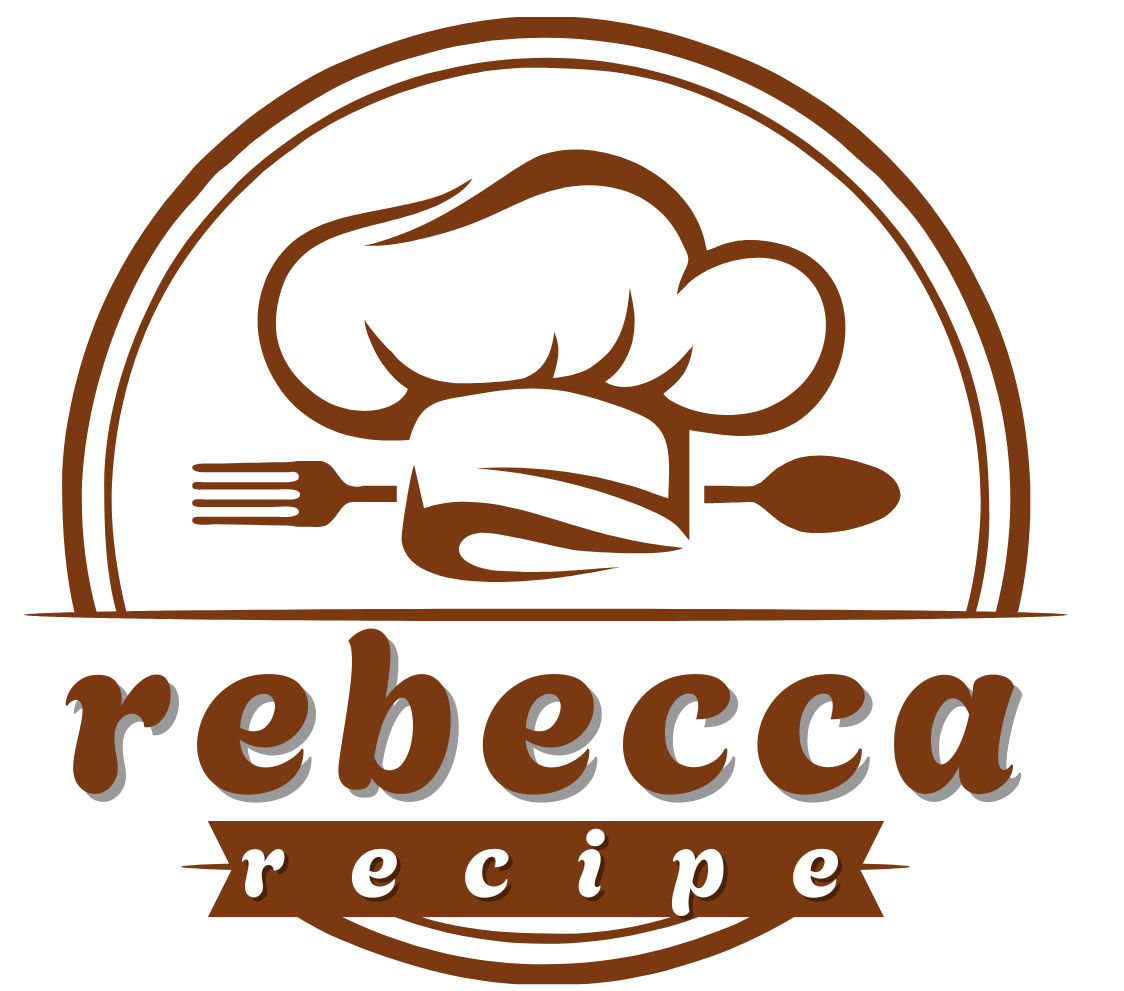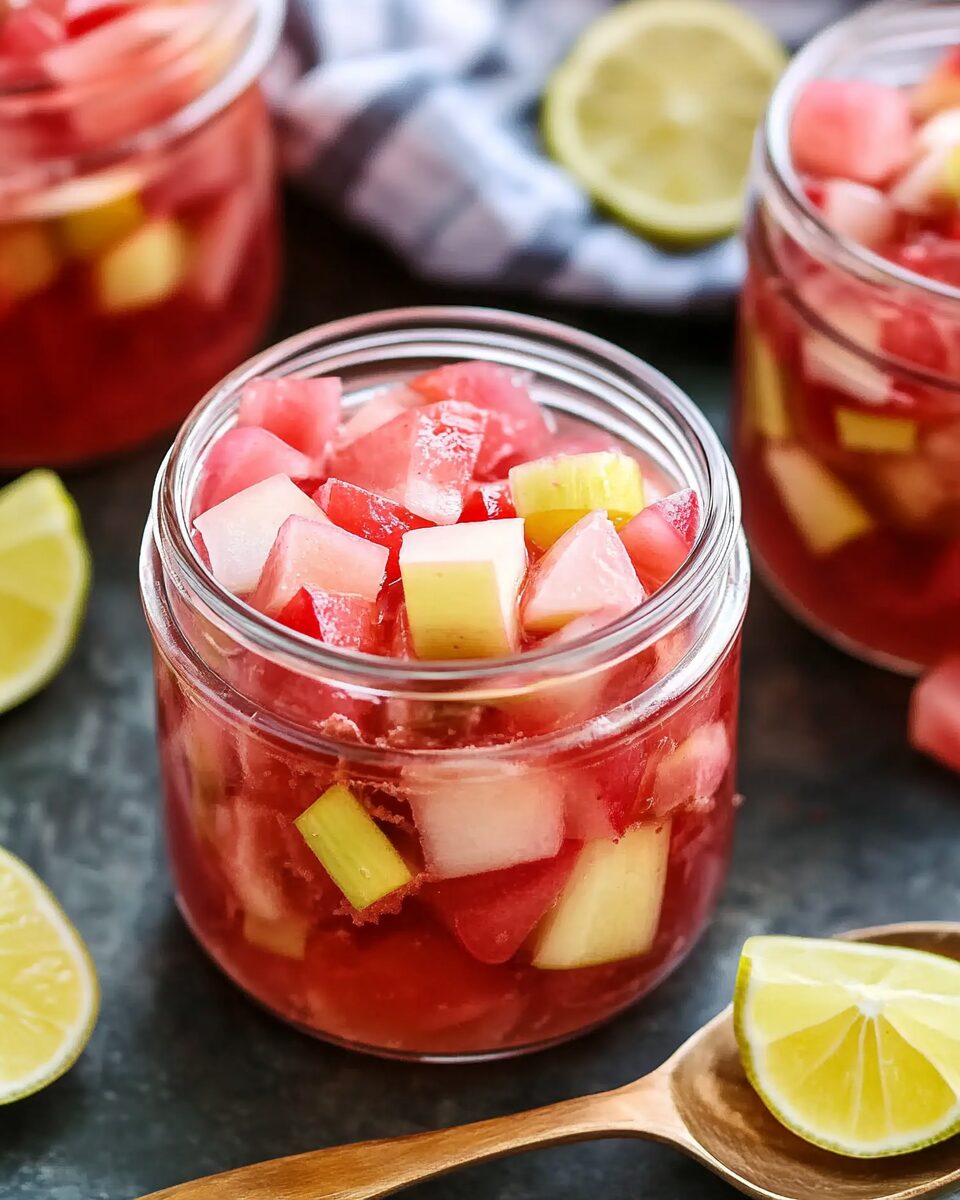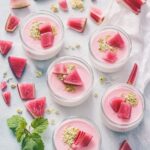Pickled rhubarb is a vibrant and tangy condiment that transforms the tartness of fresh rhubarb into a sweet and sour delight. With its crisp texture and bold flavor, pickled rhubarb adds a unique twist to a variety of dishes, from cheese platters to grilled meats. This quick and easy recipe requires minimal ingredients and time, making it an excellent choice for both novice and experienced home cooks.
Full Recipe:
Ingredients
- Fresh rhubarb stalks
- Lemon zest
- Granulated sugar
- Water
- Red wine vinegar (or substitute with apple cider vinegar, white wine vinegar, or distilled white vinegar)
- Salt
Note: For exact quantities, please refer to the original recipe.
Directions
- Place chopped rhubarb and lemon zest into a clean 1-pint glass jar.
- In a small saucepan, combine sugar, water, vinegar, and salt. Bring the mixture to a boil over medium-high heat, stirring until the sugar dissolves.
- Carefully pour the hot brine over the rhubarb and lemon zest in the jar, ensuring the rhubarb is fully submerged.
- Allow the mixture to cool completely at room temperature, uncovered, for about 2 hours.
- Once cooled, seal the jar with a lid and refrigerate for at least 24 hours before serving.
Nutritional Facts (per serving)
- Calories: Approximately 50
- Carbohydrates: 13g
- Sugars: 12g
- Fiber: 1g
- Protein: 0g
- Fat: 0g
- Sodium: 100mg
The Health Benefits of Rhubarb
Rhubarb is not just tasty—it’s also packed with nutrients that can benefit your health. As a low-calorie vegetable (often treated as a fruit), rhubarb provides a variety of important vitamins and minerals. It’s particularly high in fiber, which supports digestive health and helps keep you feeling full longer. Rhubarb also contains antioxidants that may help reduce inflammation and protect the body from oxidative stress.
One of the notable health benefits of rhubarb is its high levels of vitamin K. This vitamin plays a crucial role in bone health by supporting calcium absorption and bone mineralization. It’s also important for maintaining healthy blood circulation. Additionally, rhubarb contains a small but significant amount of vitamin C, which helps boost the immune system and promote skin health.
The pickling process itself doesn’t diminish the nutritional value of rhubarb, making pickled rhubarb a healthy addition to your diet. The brine, composed of vinegar, salt, and sugar, adds minimal calories, allowing you to enjoy this condiment without worrying about overindulging. However, it’s worth noting that the high sodium content in pickled foods could be a concern for individuals on a low-sodium diet, so moderation is key.
Why Pickle Rhubarb?
Pickling is an age-old method of preserving food, and it’s one that has stood the test of time. The benefits of pickling go beyond simple preservation, as the process can enhance the flavor of foods in unique and interesting ways. For rhubarb, pickling not only extends its shelf life but also helps to mellow out the natural tartness of the vegetable, creating a more balanced flavor profile. The tangy and slightly sweet brine complements the rhubarb’s natural acidity, resulting in a condiment that works well with a wide variety of dishes.
Pickled rhubarb is also an excellent way to make the most of seasonal produce. Rhubarb is typically available in the spring and early summer, but by pickling it, you can preserve it for months, allowing you to enjoy its vibrant flavor long after the growing season ends. The versatility of pickled rhubarb means that it can be used in a variety of dishes, making it a great option for anyone who loves experimenting with new ingredients and flavors.
The Versatility of Pickled Rhubarb in Cooking
Pickled rhubarb is an incredibly versatile ingredient that can be used in many different ways. One of its most popular uses is as a garnish or condiment for meat dishes. The bright, tangy flavor of the pickled rhubarb pairs exceptionally well with rich meats like pork, beef, or lamb. It can also complement grilled chicken or fish, adding a fresh and vibrant contrast to the savory flavors of the protein.
Beyond meat dishes, pickled rhubarb also shines when used in salads. Its crisp texture and acidic flavor can help balance the richness of creamy dressings or fatty ingredients like avocado and cheese. It can also be used in grain-based salads, adding a burst of flavor and color to a simple salad made with quinoa, couscous, or farro.
In addition to savory dishes, pickled rhubarb can be a unique addition to desserts. Its tartness can cut through the sweetness of pastries, cakes, or pies, offering a refreshing contrast. For example, it can be paired with a rich cheesecake or used as a topping for a fruit salad. The pickling process also softens the rhubarb, making it more palatable and less fibrous, which is particularly important when using it in sweet dishes.
Pickled rhubarb can even be added to sandwiches, wraps, or tacos to give them an unexpected punch of flavor. Its acidity can brighten up a dish, making it feel lighter and more refreshing. Additionally, it pairs well with a variety of cheeses, including soft cheeses like goat cheese and cream cheese, as well as sharp cheeses like blue cheese or cheddar.
How to Store and Preserve Pickled Rhubarb
One of the greatest advantages of pickled rhubarb is its ability to be preserved for an extended period. Once prepared, pickled rhubarb can be stored in a glass jar in the refrigerator for up to a few weeks. This makes it an excellent option for meal prep, as you can make a large batch in advance and have it on hand whenever you need it.
To store pickled rhubarb, ensure that it is placed in a clean, airtight jar and that the brine fully covers the rhubarb. This will help prevent any spoilage and ensure the rhubarb remains crisp and flavorful. If you plan to keep it for an extended period, you can also can the pickled rhubarb using a hot-water bath method, which will allow it to be stored at room temperature for several months.
For those who like to experiment with different flavor profiles, the pickling brine can be modified to include additional spices or herbs. Some people enjoy adding mustard seeds, coriander, or even cinnamon to their pickled rhubarb to give it a more complex flavor. Feel free to play around with different combinations until you find the one that suits your taste.
The Simplicity of Making Pickled Rhubarb
One of the most appealing aspects of making pickled rhubarb is its simplicity. The recipe requires just a handful of ingredients—rhubarb, sugar, vinegar, salt, and lemon zest—and can be prepared in just a few hours. This makes it an ideal recipe for home cooks who may not have a lot of experience with pickling or preserving foods. Additionally, pickling rhubarb doesn’t require any special equipment, such as a pressure canner, which makes it more accessible to the average home cook.
The process of making pickled rhubarb is straightforward and doesn’t take much time or effort. Simply chop the rhubarb, prepare the brine, and let the mixture cool before storing it in the refrigerator. It’s a quick and easy way to preserve this delicious and seasonal vegetable.
Conclusion
Pickled rhubarb is a delightful and versatile condiment that can elevate a wide range of dishes with its tangy, flavorful bite. Whether used as a topping for meats, added to salads, or incorporated into desserts, pickled rhubarb offers a unique and refreshing twist on the traditional pickling process. Its health benefits, ease of preparation, and ability to pair with a variety of dishes make it an excellent choice for both novice and seasoned cooks alike.






